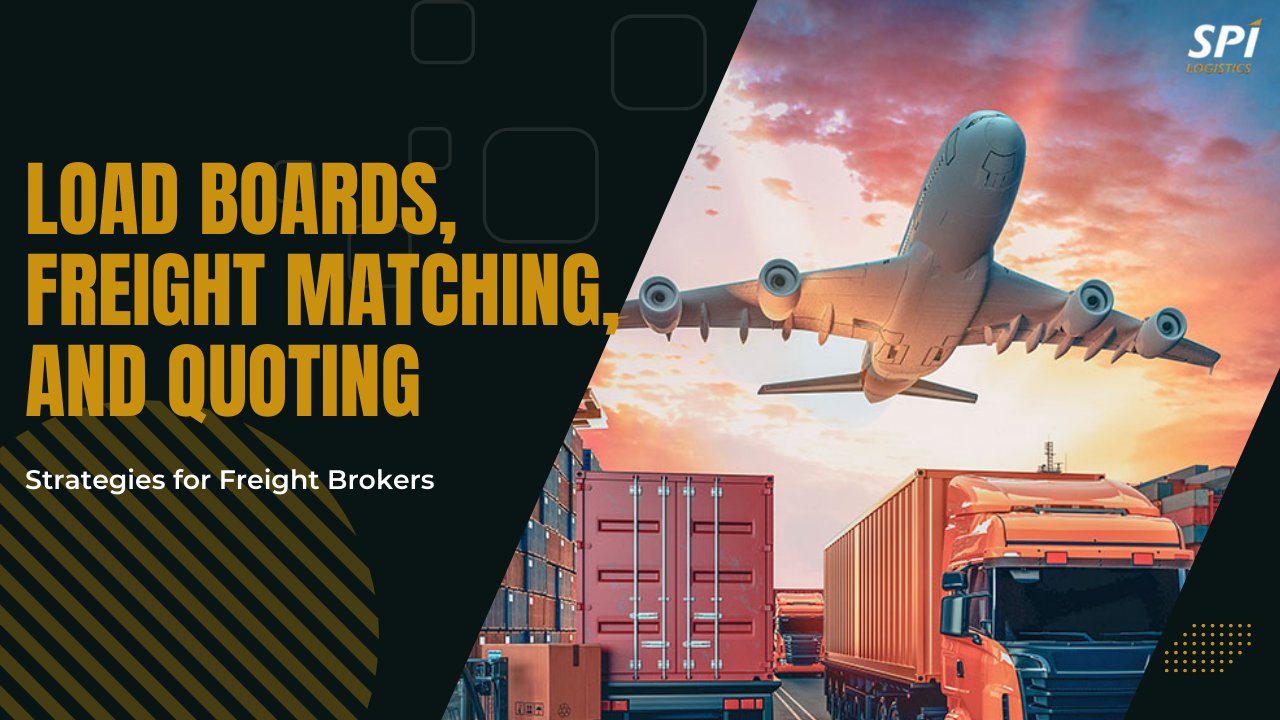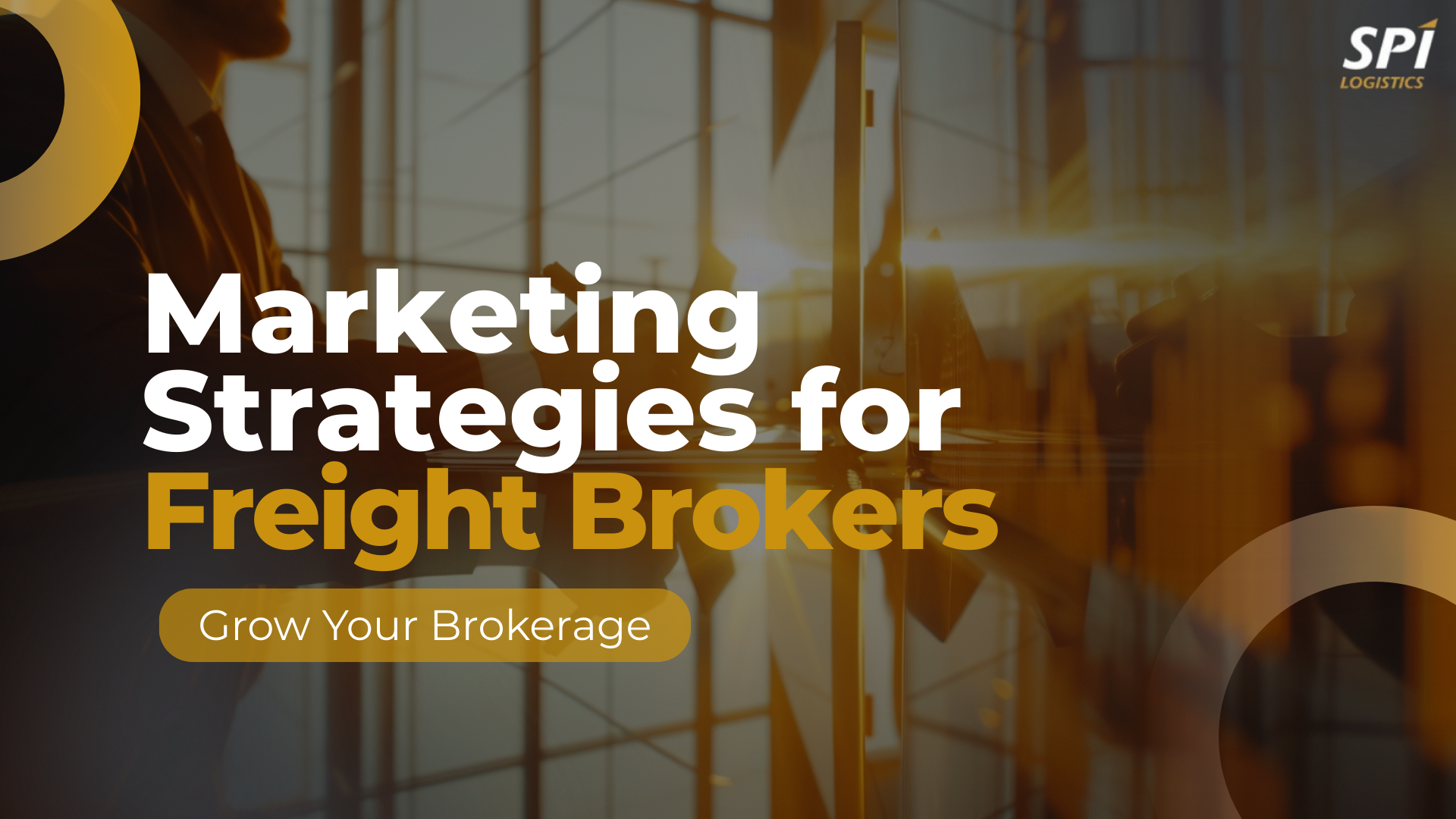Freight brokerage is a competitive, high-pressure business where the way brokers use load boards and craft quotes directly shapes profitability and long-term success. Successful brokers leverage load boards not just to find capacity, but to gain market intelligence, secure reliable carriers, and optimize rates. Here’s a comprehensive guide to using load boards strategically, building private carrier networks, and quoting effectively.
Choosing the Most Effective Load Boards for Independent Brokers
Selecting the right load board is critical for independent brokers aiming to find capacity efficiently while maximizing profitability. Here’s a breakdown of the most effective options and key considerations before diving into the details:
Top load boards:
- DAT – Extensive coverage and rate insights (DAT Solutions, 2024).
- Truckstop – Strong tools for posting loads and tracking carrier performance (Truckstop.com, 2024).
- Others – 123Loadboard, FreightFinder, and private TMS-integrated platforms.
Key Factors to Consider When Choosing a Load Board:
- Availability of carriers: A platform with a large, active carrier base increases your chances of finding trucks quickly. For example, DAT offers broad national coverage, while some niche boards specialize in regional lanes (DAT Solutions, 2024).
- Market rate data: Access to real-time and historical pricing helps you negotiate effectively. For instance,Truckstop provides benchmarking tools to guide rate decisions (FreightWaves, 2024).
- Lane coverage: Ensure the board covers the geographic regions and lanes your shippers demand. A broker handling Midwest to East Coast freight should verify strong carrier presence in those corridors (Truckstop.com, 2024).
- Advanced search filters: Features like filtering by equipment type, carrier safety rating, or service history help you avoid wasting time on unqualified options (FMCSA, 2023).
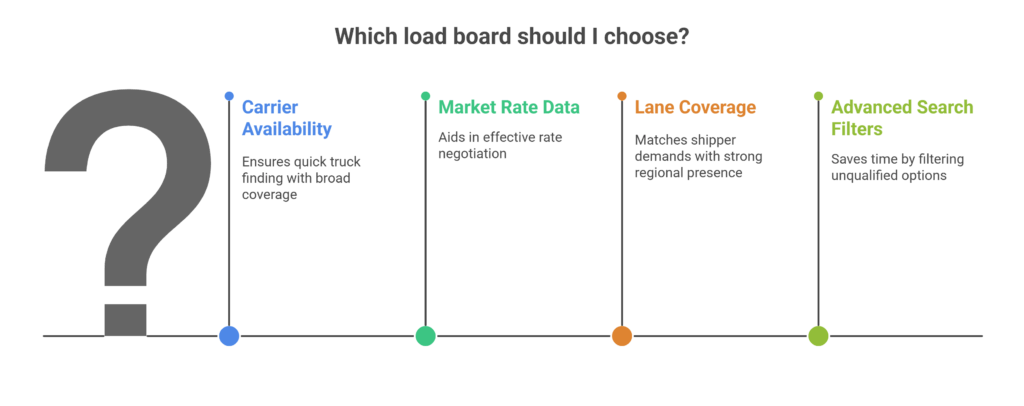
Tip: Test multiple platforms and track ROI per board to identify the most profitable.
“High-performing brokers often combine public load boards with private networks to maintain flexibility while reducing dependency on volatile spot markets.”
Which load boards have consistently provided the highest-margin loads for your lanes?
Understanding Load Board Subscription Costs
Subscription tiers vary by platform:
- Basic/free versions – Limited access, suitable for occasional loads.
- Professional tiers – Full access to analytics, rate data, and carrier ratings (Truckstop.com, 2024).
- Enterprise/Custom plans – Designed for high-volume brokers; includes automated alerts and API integrations.
Consider ROI vs. cost: sometimes a higher-priced subscription pays off by delivering better lanes, more accurate rate data, and access to reliable carriers.
For instance, paying extra for DAT’s Power or Truckstop’s Pro plan may feel expensive upfront, but if it helps secure just one profitable lane or avoid working with a bad carrier, the subscription cost can quickly be justified. Brokers should weigh whether cheaper plans limit their ability to compete, while higher tiers often provide advanced search filters, market analytics, and expanded carrier networks that directly impact profitability
“Investing in a premium load board subscription often reduces wasted hours chasing unprofitable loads.”
How do you calculate whether a load board subscription is worth the investment?
Finding Profitable Loads and High-Demand Lanes Using Load Boards
Steps to identify profitable opportunities:
- Analyze prevailing market rates and fuel surcharges in detail (FreightWaves, 2024). For example, compare current DAT rate trends against Truckstop benchmarks to see whether a lane is rising or falling. Factor in fuel surcharges and accessorials to calculate the true cost.
- Focus on high-demand lanes with consistent volume. Identify corridors where shippers move freight daily, such as Midwest-to-East Coast lanes, to ensure steady revenue and better negotiating power.
- Target reliable carriers who meet equipment and service standards. Check safety ratings, past on-time performance, and equipment type (reefer, flatbed, dry van) before awarding loads (FMCSA, 2023).
- Evaluate lane seasonality and volatility. Some lanes spike during produce season or holidays; anticipate these changes to quote proactively.
- Review shipper requirements and service levels. High-value or time-sensitive freight requires carriers with proven capabilities, even if rates are higher.
- Assess profit margins vs. opportunity costs. A load may look profitable on paper, but tying up a truck could cause you to miss a better-paying lane.
- Incorporate technology tools like TMS dashboards or rate analytics to refine your decision-making and automate comparisons.
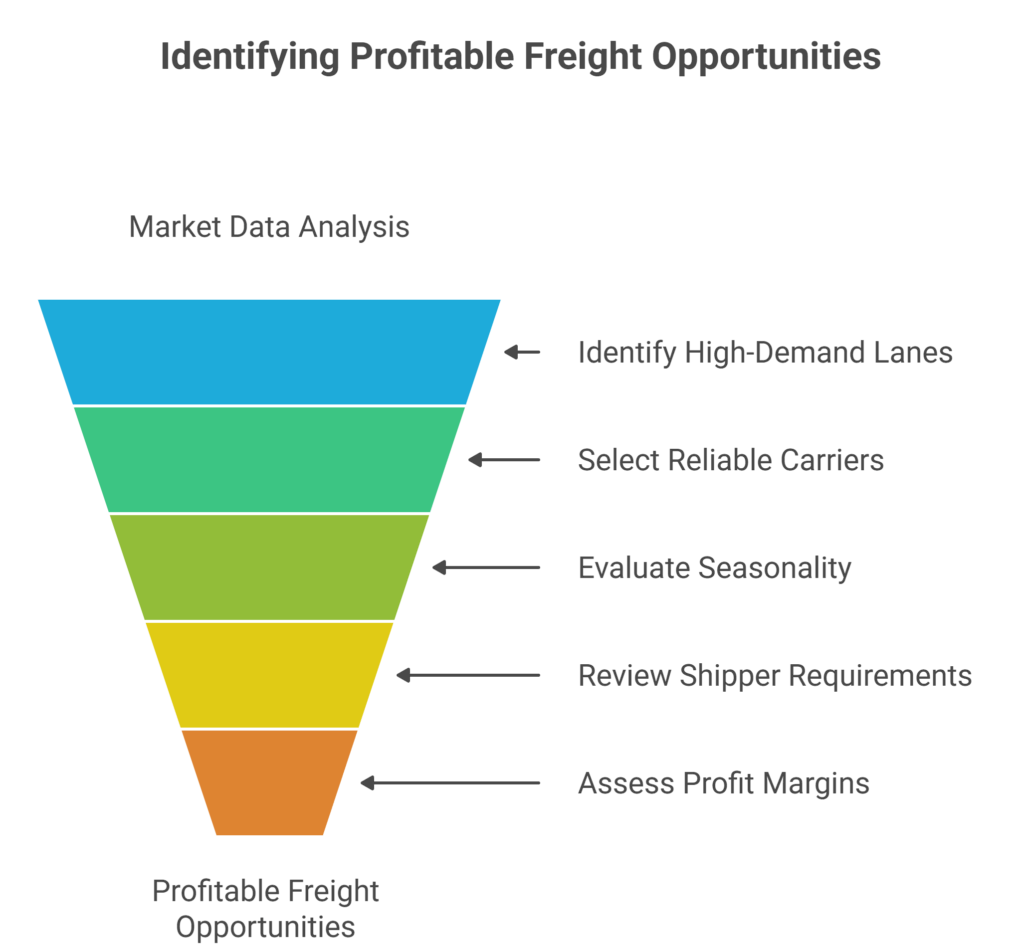
Use historical lane performance and spot trends to anticipate pricing spikes.
“Profitability comes from matching lane demand with carriers willing to operate at competitive rates without sacrificing quality.”
What metrics do you track to determine the most profitable lanes for your brokerage?
Advanced Load Board Search Strategies for Quality Carriers
Use filters for:
- Carrier ratings and reviews.
- Equipment type (reefer, flatbed, dry van, etc.).
- Regional preferences and lane familiarity.
Leverage keywords in search (e.g., “preferred carrier,” “dedicated routes”) to narrow results.
“Experienced brokers often maintain a watchlist of carriers who have consistently met deadlines and service requirements.”
Which advanced search filters have saved you the most time and improved load matching?
Posting Loads Effectively to Attract Qualified Carriers
Best practices:
- Provide clear load details, including weight, dimensions, and pick-up/delivery windows (DAT Solutions, 2024).
- Highlight special requirements or incentives (Truckstop.com, 2024).
- Include accurate rate information to filter out non-serious carriers (FreightWaves, 2024).
- Add contact information and preferred communication methods so carriers can respond quickly.
- Specify equipment requirements (reefer, flatbed, dry van, etc.) to avoid mismatches.
- Mention pickup and delivery flexibility (if any) to attract more interest.
- Emphasize safety or compliance standards (e.g., minimum safety rating) to deter unqualified carriers.
- Use clear formatting (bullet points, concise sentences) to make postings easy to read.
“Well-crafted load postings reduce negotiation time and increase acceptance by quality carriers.”
How do you optimize your load postings for maximum carrier engagement?
Alternatives to Public Load Boards
While public load boards are essential for finding capacity quickly, many brokers enhance reliability and profitability by building private networks. Here’s how brokers can supplement public boards with direct and curated carrier connections:
- Direct outreach to carriers via email, phone, or LinkedIn.
- Partnerships with regional or niche carriers (DAT Solutions, 2024).
- Private TMS-integrated networks for automated load matching.
Benefits: Consistent service, better rates, and fewer unknown carriers.
“Brokers who cultivate private networks often experience higher margins and fewer service disruptions.”
What strategies have you used to develop a reliable private carrier network?
Leveraging Load Board Data for Market Rate Analysis and Accurate Quoting
Load boards are more than just tools for finding available trucks, they are treasure troves of pricing and capacity data. When used strategically, this information helps brokers generate accurate quotes, negotiate better with shippers, and anticipate market shifts. Here are practical ways to harness load board data for smarter quoting:
- Track spot market trends for fuel costs and lane demand (FreightWaves, 2024).
- Compare rates across platforms to identify underpriced opportunities.
- Integrate load board data into TMS or quoting tools for faster, accurate proposals.
- Analyze historical pricing patterns to anticipate seasonal fluctuations.
- Use lane-specific benchmarking to compare your quotes against regional norms.
- Incorporate real-time fuel indexes to adjust quotes quickly when fuel prices shift.
- Monitor carrier capacity trends (surplus vs. shortage) to gauge bargaining power.
- Apply predictive analytics (if available) to forecast upcoming rate changes.
- Share summarized data insights with shippers to build credibility and justify rates.
- Regularly conduct profit margin reviews to ensure quotes remain both competitive and sustainable.
“Real-time data allows brokers to quote competitive yet profitable rates confidently.”
How often do you update your quotes based on current market data?
Risks of Over-Reliance on Load Boards
Relying too heavily on load boards might feel convenient, but it can expose brokers to a variety of challenges that ultimately hurt profitability and service quality. Instead of treating load boards as a one-stop solution, brokers should understand the potential downsides and develop strategies to balance them out. Key risks include:
- Unknown carriers increase risk of late deliveries or service issues (FMCSA, 2023).
- Volatile spot market rates can erode profit margins (DAT Solutions, 2024).
- Overuse reduces opportunities for direct carrier relationships.
- Higher competition on public boards often drives rates downward, creating a race to the bottom.
- Limited visibility into carrier reliability compared to private networks.
- Increased exposure to fraud or double-brokering when working with unverified carriers.
- Missed opportunities to build long-term partnerships that lead to dedicated lanes and better pricing.
- Dependence on boards can reduce your negotiating leverage with both shippers and carriers.
“Treat load boards as a supplement, not a primary source of capacity, to mitigate operational risks.”
Looking to strengthen your brokerage compliance and minimize risk? Discover how to manage freight broker compliance and risk effectively.
How Automated Freight Matching Systems Work and Their Effectiveness
Automated freight matching systems streamline the process of connecting loads with carriers. Before diving into the benefits, it’s helpful to understand how these systems operate and what to watch for when integrating them into your workflow.
- Function: Automatically matches shippers’ loads with available carriers based on parameters like equipment, location, and delivery timing.
For example, a broker handling refrigerated produce can match only carriers with reefer trucks available along the required route and pickup window.
- Benefits: Saves time by reducing manual searches, reduces errors by ensuring proper equipment and carrier qualifications, and improves efficiency through faster load assignments.
For instance, matching 50 repetitive lanes daily becomes manageable with automation.
- Effectiveness: Best for high-volume brokers or repetitive lanes where similar shipments are booked frequently. Small brokers may benefit too, but human oversight is still needed for complex or high-value loads.

“Automation enhances productivity but should complement, not replace, relationship-driven brokerage.”
Have automated matching systems improved your load-to-carrier efficiency?
Quoting Shippers Accurately
Steps for effective quoting:
- Calculate carrier pay and fuel surcharges (Truckstop.com, 2024).
- Include accessorial costs (detention, layover, special handling).
- Add your target margin.
- Compare market rates for competitiveness.
“Transparent quoting builds trust with shippers while protecting profitability.”
How do you ensure your quotes are competitive without undercutting your margins?
Technology Tools to Automate Load Matching and Quoting
- TMS platforms – Centralize load tracking, quoting, and carrier communication. For example, a TMS like McLeod or Ascend allows brokers to track multiple shipments, monitor carrier performance, send automated updates to shippers, and generate profitability reports for each lane.
- APIs with load boards – Automate search and posting. Integrating your TMS with load board APIs such as DAT or Truckstop enables automatic posting of new loads, real-time retrieval of carrier availability, and automatic updates on load status, saving time and reducing manual errors (DAT Solutions, 2024).
- Rate benchmarking tools – Quickly generate competitive quotes using historical data. Tools like DAT RateView or Truckstop SmartQuotes let brokers analyze historical lane rates, adjust for fuel surcharges, compare margins, and generate quotes that are both competitive and profitable. These tools can also highlight underpriced lanes to help identify high-margin opportunities (Truckstop.com, 2024).
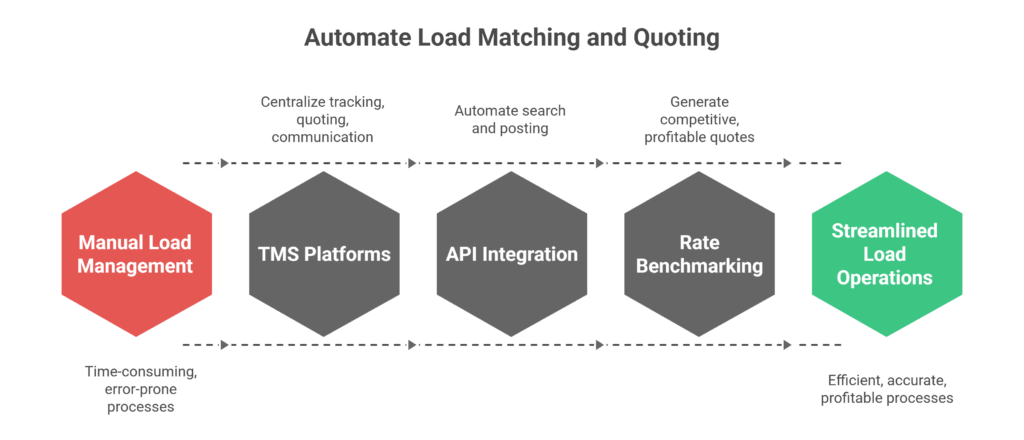
“Technology streamlines repetitive tasks, letting brokers focus on building carrier and shipper relationships.”
Looking to boost your brokerage efficiency? Discover the best freight broker technology solutions.
Frequently Asked Questions (FAQs)
1. What is the difference between public load boards and private carrier networks?
Public load boards provide open access to carrier capacity, while private networks rely on pre-vetted carriers, offering more consistent service and better rates.
2. How often should I update my shipper quotes based on market data?
Ideally, quotes should be updated daily or weekly depending on lane volatility, fuel cost fluctuations, and demand trends.
3. Can automated freight matching replace manual broker work entirely?
No. Automation improves efficiency and speed but cannot fully replace human judgment, relationship management, and negotiation skills.
Optimize Your Freight Operations
Effectively using load boards, freight matching systems, and quoting strategies requires a balance of technology, market insight, and strong relationships. Independent brokers who combine public boards with private carrier networks, leverage data for accurate quoting, and use automation to streamline repetitive tasks can maximize profitability while minimizing risk. Remember to continually analyze market trends, monitor carrier performance, and invest in tools that enhance efficiency without replacing the human judgment critical to brokerage success. By applying these strategies, brokers can not only secure high-margin loads but also build long-term, trust-based partnerships with shippers and carriers, positioning themselves for sustainable growth in a competitive industry.
Ready to optimize your freight operations and secure better loads? Contact us for expert guidance and tools to grow your brokerage.
References
Federal Motor Carrier Safety Administration (FMCSA). (2023). Carrier Compliance and Safety Ratings. Retrieved from https://www.fmcsa.dot.gov
DAT Solutions. (2024). DAT Load Board and Market Insights. Retrieved from https://www.dat.com
Truckstop.com. (2024). Load Board Tools for Brokers. Retrieved from https://truckstop.com
FreightWaves. (2024). Load Board Analytics and Market Data. Retrieved from https://www.freightwaves.com

